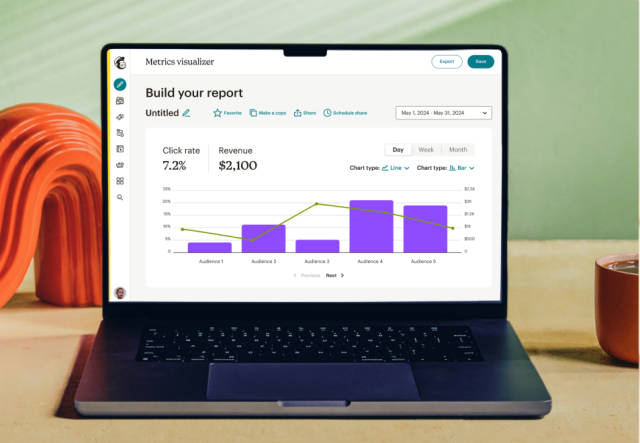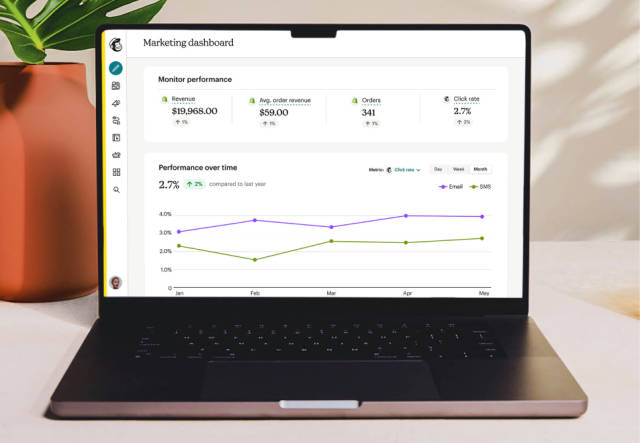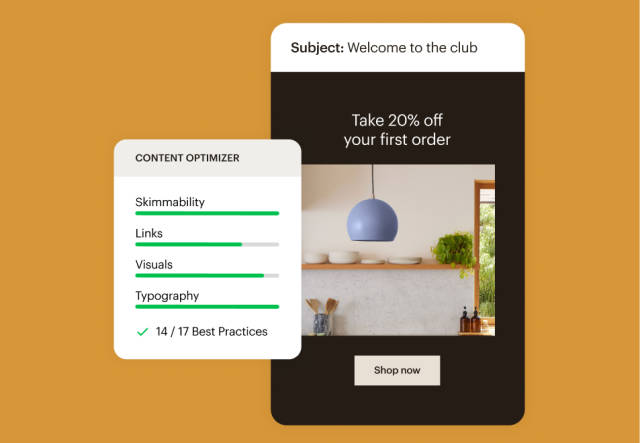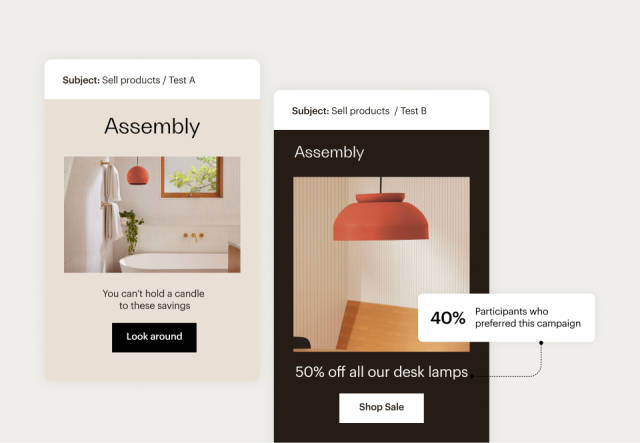ANALYTICS & REPORTING TOOLS
Optimize your marketing strategy with analytics and reporting tools
Track trends, get data-driven insights, and create engaging campaigns that drive conversions. Our analytics tools help you get ahead of your next challenge.

Find out why we’re best-in-class
The #1 AI-powered email marketing and automations platform* that recommends ways to get more opens, clicks, and sales.
-
Up to 25x ROI
seen by Mailchimp users*
-
>99% deliverability rate
for email (average)
-
11M+ users
of Mailchimp globally
-
50+ behavior-based triggers
for personalization
Make smart decisions faster with access to all of your data in one place
See the big picture with comprehensive visualization
Go from data to insights with ease. Filter dashboards by audience, campaigns, and ecommerce metrics over custom timeframes to help you understand what you’re seeing.


Dive deeper with customized reporting
Build customizable reports and visualizations to gain more detailed insights on the revenue and engagement metrics that matter most.
Find out what makes your customers tick with personalized recommendations
Intelligence-backed tools with serious sales muscle
By benchmarking your data and email content against millions of other data points from within your own industry, our AI-powered platform makes suggestions that can help you optimize your content and drive conversions.


"Mailchimp's reporting tools and campaign dashboard were a big part of what motivated me to change our email strategy... Mailchimp made it easier to see our performance and make changes to strategy."
Lauren Korus, Content Manager, Vacation Races
Get a headstart with a personalized product tour
Start using your new tools with confidence thanks to one-on-one support from an onboarding specialist—part of every Premium and Standard plan.*
Test and optimize your campaigns to maximize effectiveness

Don’t assume the value of your content–prove it
Use multivariate and A/B testing to gain data-driven insights that help you understand how small changes drive improved engagement.
Premium
Scale fast with dedicated onboarding, unlimited contacts, and priority support; built for teams.
Talk to Sales You've selected more contacts than this plan allows
Starts at
Starts at $2450 per month for {contacts} contacts
- Phone & Priority Support
- Custom-coded and Pre-built Email Templates
- Multivariate and A/B Testing
- Enhanced Automated Customer Journeys
- Dedicated Personalized Onboarding
- Predictive Segmentation
- Campaign Manager
Standard
Sell even more with personalization, optimization tools, and enhanced automations.
Contact limit exceeded You've selected more contacts than this plan allows
Starts at
Starts at $130 per month for {contacts} contacts
- 24/7 Email & Chat Support
- Custom-coded and Pre-built Email Templates
- Multivariate & A/B Testing
- Enhanced Automated Customer Journeys
- Personalized Onboarding
- Predictive Segmentation
- Campaign Manager
Essentials
Send the right content at the right time with testing and scheduling features.
Contact limit exceeded You've selected more contacts than this plan allows
Starts at
Starts at $85 per month for {contacts} contacts
- 24/7 Email & Chat Support
- Pre-built Email Templates
- A/B Testing
- Basic Automated Customer Journeys
-
Personalized Onboarding
-
Predictive Segmentation
-
Campaign Manager

See terms


See terms

See Trial Terms. Overages apply if contact or email send limit is exceeded.

Free
Easily create email campaigns and learn more about your customers.
Contact limit exceeded You've selected more contacts than this plan allows
Starts at
Starts at $0 per month for {contacts} contacts
- Email support for first 30 days
- Pre-built Email Templates
-
A/B Testing
-
Basic Automated Customer Journeys
-
Onboarding
-
Predictive Segmentation
-
Campaign Manager
*Overages apply if contact or email send limit is exceeded. Free plan sending will be paused if contact or email send limit is exceeded.
Learn moreLearn more about reporting and analytics
Need to hire a helping hand? We got you.
From a quick template design to full-service campaign management, our global community of 850+ trusted experts does it all.

We offer expert 24/7 customer service
Our customer service team is always available and ready to support you.
FAQs
-
Email analytics provide valuable insights that allow you to identify what’s working for your business and refine campaigns that can be made even better. The data provided can sometimes be difficult to decipher, but you’ll always receive digestible, easy-to-read insights with our digital marketing reporting software.
Our analytics and reporting tools work by monitoring the engagement, growth, and revenue of your campaigns across different channels. This includes emails, social media ads, promo codes used, and so forth. As a result, you can gain a deeper understanding of what your customers like and continue creating content that fits their needs. Digital marketing reporting tools also allow you to see how your email campaigns compare to the competition. The best part is that you can do this without ever leaving the Mailchimp analytics dashboard.
-
Email analytics can be difficult to grasp, especially for small business owners who don’t know where to begin. However, it doesn’t have to be this way. With Mailchimp data analytics, you can start making more informed business decisions with reports packed with the necessary insights.
Our marketing reporting tools can provide email campaign, automation, landing page, and ad reports to ensure you get a comprehensive overview of your previous and ongoing campaigns. Each one will dive deep into different metrics. For instance, landing page reports will measure how well your landing pages are doing with views and clicks.
By using digital marketing analytics tools, you can develop an action plan based on the data you gather. Ultimately, reporting and analytics tools create a valuable opportunity to further enhance your marketing efforts and grow your business. Whether you want to segment customer data based on demographics or identify underperforming content, we’re here to help.
-
Our analytics reporting tools will start gathering data as soon as your email campaign is published and your audience begins engaging with it. Mailchimp’s reporting tools will also analyze data received from clicks, opens, and purchases. However, you may not be able to see the results of your campaign right away since some emails can take time to send and be delivered.
You can view a summary of your campaign’s performance by opening your email campaign report. The overview we provide includes crucial information that can influence your next campaign, such as the total order revenue earned, open rate, unsubscribed recipients, and more.
-
If you want to receive automated campaign reports from Mailchimp, all you have to do is enable tracking. Then, our analytics reporting tools will take care of the heavy lifting and provide insight into how well your automated emails are doing as a series. You’ll also be able to view Mailchimp analytics on individual emails.
Here’s how to access classic automation reports:
- Select Reports under the Campaigns tab.
- Click Automations and then View Report.
Once you open the automation report, you’ll be able to see different metrics, like the number of emails sent and monthly performance.
-
Reporting is about collecting and presenting data in a clear way, giving you a snapshot of what's happening. Analytics digs deeper into the data, finding patterns and insights to help you make decisions. Reporting shows you the facts, while analytics helps you understand what it all means.
-
Digital marketing analytics is all about collecting, analyzing, and making sense of data from your digital marketing efforts. It helps you track metrics, measure performance, and get insights that guide your marketing decisions. By diving into digital marketing analytics, you can optimize your strategies and get better results across your campaigns.
-
Analytical reporting tools help you understand the performance of your marketing efforts through data. They're invaluable for measuring the impact of your campaigns, understanding audience behavior, creating interactive dashboards and making data-driven decisions about your marketing strategy.
Mailchimp's powerful data reporting tools and analytics keeps you ahead of the curve with real-time campaign stats, AI-assisted content optimization, actionable insights about audience behavior, and comparisons of your email performance with other businesses in your industry.
-
Analytics and reporting are both tools for using data to make better decisions. Reports gather information about something and present it in a clear, understandable way (usually in interactive reports), while analytics looks for patterns in those data sources and make recommendations for action. To use email marketing as an example, a report might tell you how many people have opened your emails, and of those, how many have acted on them—perhaps by going to your website. In the same example, analytics might inform your data analysis that most of the people who visit your website are under 35 years old, and suggest making sure your future emails appeal to a younger demographic.
-
Anything that can be tracked and measured can also be reported on. In digital marketing, some of the types of reports commonly used include:
Campaign reports track the effectiveness and reach of your content across multiple channels. This can include multiple data sources like email performance, automation stats, landing page metrics, ad response, and social post engagement.
Audience reports tell you more about the people interacting with your campaigns: how your audience is growing, their general demographics and location, and how engaged they are with your content.
E-commerce reports give you insight into your revenue and customers, including purchase stats, conversion rate, and return on investment in your advertising spend.
Mailchimp's marketing platform offers these types of reports, and way more: detailed website stats, Customer Journey progress, postcard and survey tracking, and even data from third-party integrations like Google Analytics.
-
A math-based discipline that seeks to find patterns in data to increase actionable knowledge. Analytics employs statistics, predictive modeling, and machine learning to reveal insights and answer questions. Weather predictions, batting averages, and life insurance policies are all the result of analytics. In the world of digital marketing, analytics is critical to understanding and predicting user behavior and optimizing the user experience (UX) to drive sales.
Here you have the 2 main purposes of marketing analytics:
- To gauge how well your marketing efforts are performing, measuring the effectiveness of your marketing activity.
- To determine what you can do differently to get better results across your marketing channels. Together, these processes let you turn raw marketing data into an action plan and make the most of your marketing dollars.
-
Marketing analytics help businesses understand their big picture. It also lets them dig down into their industries' more focused, micro-marketing trends. The data can improve the number and quality of leads by letting businesses know how to optimize their advertising and target the most desirable clients. All of this improves your bottom line.
-
Data reporting is the process of taking a bunch of raw data from multiple sources and converting it into a format that you can understand easily. Your time is your most important resource, and you probably have a lot of automated tools collecting complex information for you.
At the same time, this information will only be helpful if you translate it into a format that is easy to understand. For example, you might convert that information into a spreadsheet that allows you to view the information quickly, pulling out the most important pieces.
Then, you will use this information to figure out what needs to be done. If you run a company, you might collect information on the various profit margins of certain products as part of your reporting process. Or, you might collect information related to the effectiveness of your digital marketing strategy.
Then, you can figure out what is working well, what is not going well, and what you need to do to improve the positioning of your company
-
Automated reporting involves automatically collecting and generating specific information that is made accessible to a particular individual on a set schedule. With report automation, a user can also create reports outside of the scheduled times to monitor the operations of a business throughout the day. Being able to access accurate and up-to-date data as it's needed is essential for any business to run efficiently.
Using marketing automation software gives you an advantage when it comes to staying on top of the different aspects of your business. Email tracking helps with marketing by providing valuable information on the effectiveness of your campaign, while an automated inventory system will tell you when your inventory is low. Being able to track data using an automated workflow program allows you to focus more of your time on running your business instead of monitoring paperwork.
-
Predictive analytics involves looking at historical data to predict future outcomes. The information generated by predictive modeling and data analytics is generally accurate in predicting a future event, but it's not perfect. However, it can be applied to a variety of scenarios that a business faces on a daily basis.
Predictive analytics uses data mining techniques, machine learning, and statistical modeling to find patterns in data and identify risks and opportunities. This area of data science is much like using a search engine, but the queries are more involved, and the resulting data is expected to be highly accurate in predicting the future.
-
The predictive analytics process starts with a problem and goes through a series of steps to achieve the desired result.
The problem can be anything from detecting fraud to ensuring shelves are stocked for the holiday season. Relevant data sets or databases are collected for examination and then processed for analysis. The data scientist then applies the relevant tool to find the desired data and then validates the results for deployment to stakeholders via a report.
-
A business intelligence system takes raw data, curates it, and transforms it into valuable insights that can inform business decisions.
In addition to strategic information, companies can also use BI tools to measure productivity and efficiency, assess different systems or processes, and audit specific business-related activities. Business intelligence resources can also include customer data. It can help companies define their target market, assess sales and marketing performance, and gain insights about customer interest and activities based on browsing history and online actions.
-
A business intelligence system handles specific data-related tasks to help companies gain insights into their business users. There are 4 key ways these tools do this.
- Raw data mining. Business intelligence tools dig through data sources for information that could be useful for business analytics. This function is essential because businesses have vast amounts of information, but it is only valuable if well-organized. Business intelligence tools can start this curation process.
- Automated reporting. Business intelligence systems usually come with centralized dashboards that analysts can use to create reports and visualize data so that decision-makers without a statistics or analytics background can understand the information.
- Performance analysis. Business intelligence tools can collect information in real time to help measure financial or operational performance. Users can enter key performance indicators for specific metrics and get insights into how the company is doing with these benchmarks.
- Predictive analytics. Business intelligence software can also take data and run it through computer models or statistical analysis tools to help predict future trends.
Millions of users trust us with their email marketing. You can too.
*Disclaimers
- 25x ROI: Based on all e-commerce revenue attributable to paid plan users’ Mailchimp campaigns from April 2023 to April 2024
- Personalized Onboarding: Onboarding services differ per plan and are available for new or upgraded users with a paid plan for the first 90 days after account creation or upgrade. Onboarding services are currently offered in English, Spanish and Portuguese for Premium plans, and in English for Standard plans.
- Availability of features and functionality varies by plan type. For details, view plans and pricing.



